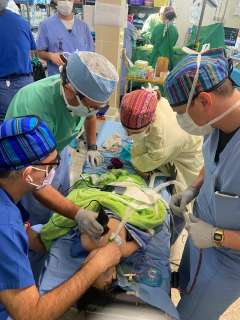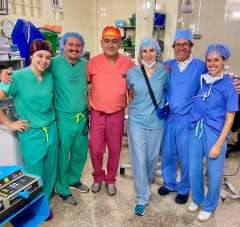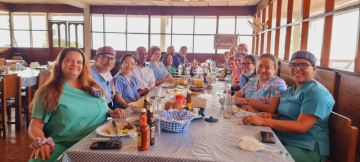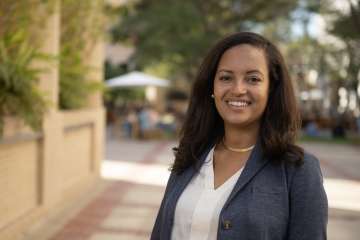DAPM Takes on Global Health
December 26, 2022 | Jane Moon, MD, and Miranda Le

While the days working in the UCLA Health operating rooms can be grueling, several members of the Department of Anesthesiology & Perioperative Medicine (DAPM) at UCLA have volunteered their vacation time in recent months to provide medical care for low-income communities around the world. Our pediatric anesthesiologists have spearheaded these efforts, which have largely focused on the surgical repair of congenital craniofacial and cardiac anomalies.
Within our own residency program, Betelehem Asnake, MD, MS, and members of the DAPM Office of Inclusive Excellence Education Committee, have recently launched a health equity curriculum and have envisioned new global health pathways. Dr. Asnake’s goal is to develop physicians who are deeply committed to alleviating global health disparities from the ground up.
Global Health Trips in 2022
In October 2022, six DAPM members—pediatric anesthesiologist Reza Borna, MD; anesthesiologist and intensivist Joseph Meltzer, MD; resident physicians Maryte Gylys, MD, and Sergey Progushev, MD; and nurse anesthetists Brianna Ortbals, CRNA, and Pauline Rioux, CRNA—joined a multidisciplinary UCLA Health effort led by pediatric craniofacial plastic surgeon Reza Jarrahy, MD, in the remote town of Nuevo Progreso in the western highlands of Guatemala.

Over the course of a week, the DAPM team provided anesthesia for over 50 surgeries—mainly pediatric cleft lip and palate reconstructions, with some adult cases as well. They often worked until 9:30 p.m. in a single operating room with three adjacent beds at the Hospital de la Familia, an established facility where Guatemalan doctors and nurses are employed full-time.
The hospital hosts seven to nine U.S. medical teams each year to provide surgical and specialty care for the local communities. All procedures requiring general anesthesia are compressed within these visits.
Equipment malfunction or disruption posed a major challenge during the trip. “We experienced failing ventilators, numerous power outages, and what almost became an operating room fire!” Dr. Progushev said.
Many patients were also poorly optimized for surgery, but canceling their cases was nearly out of the question. “We heard that some of them were traveling, like driving six to seven hours just to get there,” Dr. Borna said. “And if we don't do the surgery, there was a chance that they would not have the surgery for another seven years.”

The team worked together to troubleshoot the issues and achieve their goals. They also celebrated their successes. Ms. Ortbals’ favorite memory from the trip was “all the dancing and singing we did—whether it was in the O.R. or at our end-of-the-week pool celebration at a local spot! This group knew how to work hard and play hard for sure!”
In August 2022, pediatric cardiac anesthesiologist Christine Trieu, MD; pediatric anesthesiologist Swati Patel, MD; and nurse anesthetist Shelly Anderson, MBA, MSNA, CRNA, braved altitude sickness and resting oxygen saturations in the 80s to provide anesthesia for children at Es Salud Hospital in Cuzco, Peru—a city that lies at an elevation of over 11,000 feet.
Their visit was organized by Medical Missions for Children (MMFC), a Massachusetts-based group that dispatches volunteer surgical teams to remote communities around the world. MMFC trips focus on the repair of cleft lip and palate, severe burn injuries, head and neck tumors, and dental disease.
As theirs was the first MMFC trip in Cuzco after a 2-year hiatus due to COVID-19, it was fraught with supply shortages and logistical challenges. Still, the team worked hard to make things work.

“We accomplished 45 surgeries in 4 days on 40 patients with an age range of a few months old to teenagers,” Ms. Anderson said. “This was an incredible accomplishment, considering we had to unpack supplies to set up three beds in two O.R.s, coordinate a pre-op clinic, set up a PACU, provide inpatient post-op care, complete the surgeries, then re-pack all of our supplies in suitcases all within 5 days!”
Dr. Trieu, who has participated in numerous mission trips throughout her career, attributes her own experience with humanitarian aid while growing up in Vietnamese refugee camps as the motivation for her work. “I am inspired to go on mission trips because I wanted to give back,” she said. “I personally benefited from kind and generous volunteers when I was a child living in the refugee camps in need of basic medical services.”
Dr. Patel, who is also Medical Director of the Ronald Reagan UCLA Medical Center Operating Rooms, not only went to Cuzco with Dr. Trieu and Ms. Anderson, but also spent a week volunteering in the city of Tagbiliran in the Philippines in September 2022. That trip was organized by the JP Clawson Medical Missions Foundation, another group dedicated to providing facial reconstructive surgeries for children with cleft lip or palate.
Also in September, pediatric cardiac anesthesiologist Tiffany Williams, MD, PhD, joined UCLA pediatric electrophysiologist Kevin Shannon, MD, on a mission trip in El Salvador. The visit was sponsored by Gift of Life International, an organization that is dedicated to caring for children with congenital heart disease and developing sustainable pediatric cardiac centers of excellence in specific international locations.
Dr. Williams worked for 12-14 hours a day providing anesthesia for Salvadorean children with symptomatic arrhythmias who were undergoing electrophysiology studies and cardiac ablations. She reflected on her experience, saying, “I am always reminded of the resilience of people and inspired by the impact a dedicated group of individuals can have in the lives of children and their families.”
Gift of Life International’s stated commitment to developing sustainable skills, structures, and resources at the local level is called “capacity building” in the global health world. The growing emphasis of global health initiatives has been to share knowledge and technological innovations with host countries while helping local leaders move toward self-sufficiency. This grassroots approach also promotes culturally appropriate interventions that are tailored for each context.
The forced interruption of global health programs by the COVID-19 pandemic brought to the forefront the need to develop host-country capabilities for long-term success.
A New Global Health Program

With this goal of capacity building in mind, Dr. Betelehem Asnake, our Director of Global Health Initiatives, has led the development of a new health equity curriculum for anesthesiology resident physicians that provides a foundational overview of several core topics: health disparities in our local communities and abroad; the value of cultural humility; structural racism within medicine and society at large; and anesthesia care in resource-constrained areas. Her vision is to foster a deep understanding of global health inequities and to equip resident physicians with the tools to provide patients with equitable care.
Several DAPM faculty members have already served as facilitators for the health equity sessions: Robert Eldridge, MD, Marisa Hernandez-Morgan, MD, MA, Jason Lee, MD, John Patton, MD, MBA, Sophia Poorsattar, MD, Mansi Sheth, MD, Cristianna Vallera, MD, and Tiffany Williams, MD, PhD.
Dr. Asnake has also initiated the creation of new global health pathways for our trainees. Once formalized, CA-1 physicians would be able to apply into an elective or research global health pathway. Resident physicians in the research track would pursue mentored scholarly projects during their CA-2 year, with the expectation of presenting their work at regional or national conferences. They would have dedicated time during their CA-3 year to teach and work closely with local practitioners at international sites.
Both the health equity curriculum and global health pathways have been structured in collaboration with the DAPM Education leadership: Judi Turner, MD, PhD, Vice Chair for Education; Jack Buckley, MD, Residency Program Director; Jason Lee, MD, Associate Program Director for Didactics and Curriculum Development; and Maxime Cannesson, MD, PhD, DAPM Chair.
Ultimately, Dr. Asnake hopes to collaborate with existing anesthesia practitioners in low-income countries on education and research initiatives to build local capacity. “The focus is not solely on traveling,” she said. “In fact, the first global health initiative being led by one of the CA-2s will be to deliver a series of lectures via Zoom to CA-1 residents in Ethiopia. This will be done in collaboration with Vanderbilt’s anesthesia program.”
In the words of the late Paul Farmer, MD, PhD, “Taking global health from a hobby to a serious pursuit is well within our reach if we commit adequate resources to a series of tasks that include research, training, and improved delivery of quality care.”1 By supporting existing DAPM endeavors while involving resident physicians in the educational and research aspects of global health, Dr. Asnake hopes to cultivate future leaders who are deeply committed to making lasting gains for the health of communities around the world.
References:
1. Farmer PE. “More than just a hobby: what Harvard can do to advance global health.” The Harvard Crimson. May 26, 2011. Accessed December 8, 2022. https://www.thecrimson.com/article/2011/5/26/health-global-training-medical/